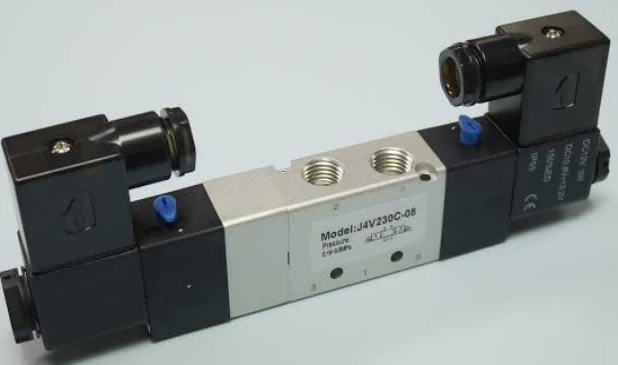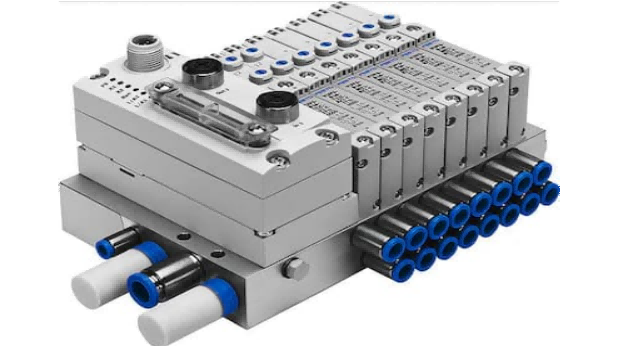Flow control systems rely on various valves, from electric and pneumatic to hydraulic. In this article, we will explain the difference between solenoid valve and pneumatic valve types. These are popular options in most applications, such as the valves of pipelines and manufacturing systems. Let’s begin with a brief description of each.
What is a Pneumatic Valve?
A pneumatic valve is an air-operated flow control device. It regulates the movement of various liquids or gases in a pipeline or other system using air pressure and can control large-diameter ports with ease.
The typical valve comprises a piston, vane, or flexible diaphragm inside a sealed chamber. These connect to a rod or stem. The rod, in turn, links to the valve control component. During its operation, the following happens:
- Compressed air flows into the sealed chamber
- The air pushes against the surface of the piston, vane, or diaphragm
- This causes a displacement that moves the connected rod or shaft
- That, in turn, moves a component inside the valve to close or open a port
- Air exhausts out of the chamber, and the mechanism returns to its former position
In some mechanisms, a return spring pulls the piston or diaphragm back. In others, air flows into the other side of the chamber to push it away. These are called double-acting pneumatic valves.
What Type of Valve is a Solenoid Valve?
The solenoid valve is an electrically operated flow control device. It generally uses a coil of wire around a magnetic core and a movable component called a plunger. Let’s briefly see how it works:
- When energized with an electric current, the coil magnetizes the core
- The plunger moves, displacing a component to open or close the valve.
- The plunger then retracts under the action of a return spring.
- Alternatively, a second coil built into the assembly pushes the plunger back.
Solenoid control valves form part of automation systems. They provide precision, accuracy, and controlled variability. You can also conveniently operate them from a remote location.

Resource: https://forum.fritzing.org
Difference Between Solenoid Valve and Pneumatic Valve
Solenoid and air-operated valves differ in many ways, from how they work to their size and other features. That also means a variation of their benefits. Below is a comparison of features to illustrate the difference between pneumatic and solenoid valves.
Working
Solenoid valves work electromagnetically using a coil assembly and a plunger that moves back and forth. The moving plunger operates the valve on/off mechanism, regulating media flow.
A pneumatic control valve uses compressed air to cause the motion that will open and close the valve. To precisely control the valve on/off (and other variables), an electric component is often incorporated.
Design
The pneumatic valve design is more straightforward. The device uses fewer parts and can be a piston, diaphragm, or vane mechanism. The solenoid valve has a more complex construction. It also uses more features.
Pneumatically controlled valves are also generally smaller than solenoid types of similar specifications. The compact nature of air-operated valves makes them suitable for applications where space is limited.
Response
A solenoid type reacts more quickly to a control signal than an air-operated valve but exerts less force. That can be both an advantage and a disadvantage. It depends on the required action.
In fast-action applications, such as manufacturing processes, solenoids may be a better choice. In pipelines where torque is more important, the higher force of a pneumatic control valve can offer more benefits.
Function
Both valve types perform a similar function, which is to control the flow of a liquid or gas through a system. For example, it can be a pneumatic air control valve to regulate the flow of compressed gas or a valve to control water flow in a pipe.
In manufacturing facilities, pneumatic and solenoid valves regulate the movement of chemicals and other materials. When paired with a control device, they automate a system, providing efficiency and convenience benefits.

Resource: https://www.packworld.com
Solenoid Valve vs. Pneumatic Valve: Which is Better?
It depends. In some applications, the pneumatic valve is a better choice. In others, solenoid types offer more advantages. A look at the benefits of both devices will help you choose wisely.
Pneumatic Valve Advantages
- Initially inexpensive
- High reliability in different conditions
- Simple and compact design
- Safe in spark or fire-prone conditions
- Usable in a broad range of temperatures
- Requires minimal maintenance
- Usable with larger loads
- More durable than a solenoid type
Solenoid Valve Advantages
- More cost-effective to run since it only requires a single power source
- Remote control option
- Extremely fast on/off operation
- Low energy requirement, which makes it efficient
These tips will help you make the right choice.
- If your application requires more force, the pneumatic control valve is the one to go for. It produces more torque.
- Choose the pneumatic valve if you need a control device to operate in hazardous conditions such as fire-prone environments with flammable materials. It will not cause a fire risk.
- If you intend to operate the valve in high temperatures, choose the pneumatic valve. It will hold up better.
- Use air-operated valves in large-diameter pipes and solenoids with smaller tubes. Pneumatic mechanisms produce more force.
- In uses where precision or accuracy is a factor, the solenoid valve is your best choice. It allows better control of the moving components and instant response times.
- If high speed is necessary, the solenoid type is the better option.
Conclusion
Knowing the differences between solenoid and pneumatic valve types is an essential part of their selection process. Because while both are popular options, they vary in many ways and fit different application needs. We hope this comparison article has provided you with the information to make the right choice based on your intended use of the valve.

